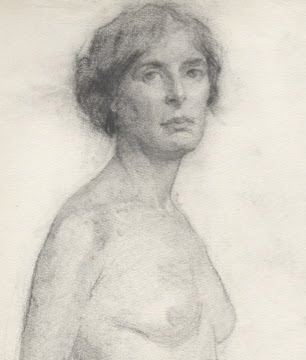These are original student drawings from the 1911 class of the famous art teacher, George Bridgman.
Bridgman, constantly inebriated and chewing on a large black cigar, would rail at his students about the importance of mastering anatomy: "Don't think color's going to do you any good. Or lovely compositions. You can't paint a house until it's built." His students adored him and vied for his approval.
Some of the students in this class would grow up to be stars, such as Norman Rockwell, Mclelland Barclay or E.F. Ward. But in 1911 they were still ambitious teenagers dreaming of the future and striving to develop the kind of academic drawing skill that many illustrators today consider irrelevant.
The crowded classroom was warmed by the stench of tobacco, charcoal, perspiration and turpentine.
Many of the models were girls who had come to the city to work in department stores during a peak holiday season and were laid off after the holidays. Desperate for money, they would apply for modeling work but once in the classroom some couldn't bring themselves to take their clothes off. Sometimes a young woman would attempt to pose in her slip and stockings, but she would be asked to leave. Recalled one of Bridgman's students, "she'd begin to cry and say she needed the money and what was she going to do."
These girls and their personal anguish are now just ghosts on crumbling paper. All that remains of them are the images that shamed them.
Bridgman was a highly critical taskmaster, teaching as he did before our era of false praise. At the end of each class, he would designate one student's work as number 1. (You can still see Bridgman's notation, "1st" on E.F. Ward's drawing of the man's back, above.) But Norman Rockwell recalled a story that Bridgman would tell the class whenever he sensed that students were getting cocky about their grades:
Boys, a queer thing happened to me after I left the class last Tuesday. There was a coal wagon backed up onto the sidewalk on 48th street shooting coal into a cellar. As I passed by a fellow stuck his head, all begrimed with coal, out of the cellar and said "hello Mr. Bridgman." I said, "why hello there who are you?" Oh, the fellow said, don't you remember me? I was number one in your class last year....The story varied; sometimes it was an iceman or a voice from a manhole.
































